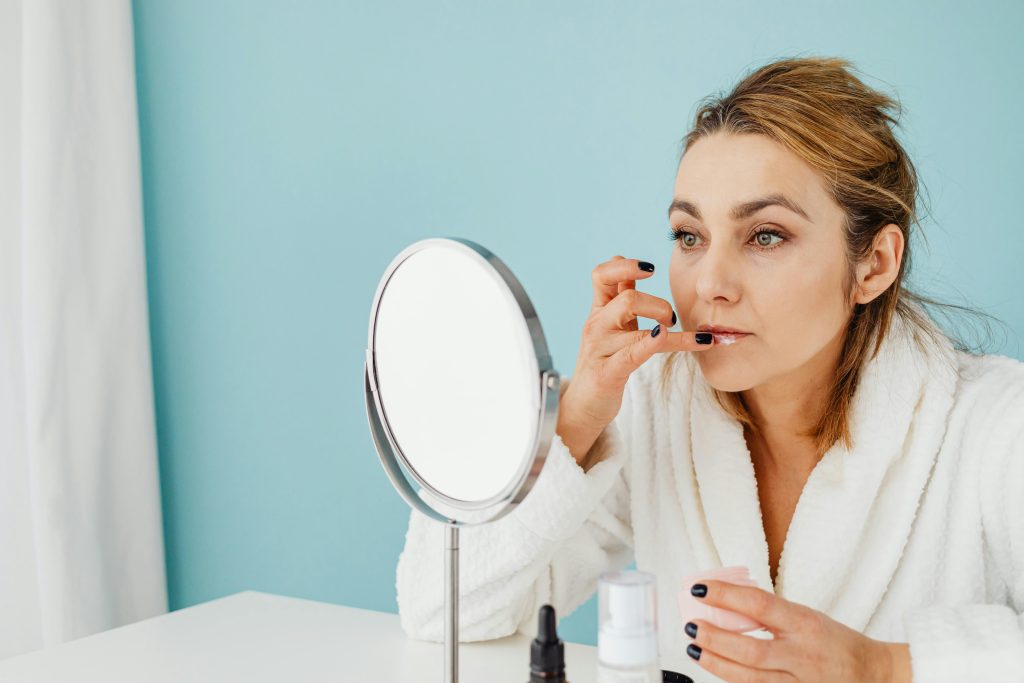Menopause, or the end of reproductive function, is a complex, multilayered transition that affects the body, psyche, relationships, and perceptions of femininity. It’s a time when familiar rhythms are disrupted, but it also opens space for reflection and inner renewal.

Menopause is diagnosed retrospectively – when menstruation has been absent for 12 months. It typically occurs between ages 45 and 52, but can be early (before 45) or premature (before 40). Physiologically, it’s linked to a decline in estrogen and progesterone production, which affects many systems in the body: thermoregulation, mood, bone density, skin and mucous membranes, libido, sleep, and metabolism.
Modern culture often silences or stigmatizes menopause, turning it into an uncomfortable topic. But more and more women are speaking openly about this stage, forming communities, sharing experiences, and reimagining themselves.
Preparing for menopause
Menopause is preceded by perimenopause, a phase of gradual changes that can last several years. It’s a time to prepare for the body’s renewed state. The more stable the support system, the smoother the transition.
Regular checkups help track changes. It’s important to examine:
- Hormonal profile: levels of follicle-stimulating hormone, estradiol, and progesterone to understand the transition stage.
- Thyroid function: dysfunction can mask or intensify menopause symptoms.
- Lipid profile and glucose: estrogen affects blood vessels and metabolism.
- Bone density (densitometry): to assess osteoporosis risk.
- General checkup: blood pressure, weight, liver and kidney function.
The goal is to understand how the body is changing and how to support it. Physical activity (strength training, yoga, swimming, dancing) strengthens bones, muscles, and blood vessels. The more muscle mass, the higher the metabolism and resilience to age-related changes. It’s important to revise nutrition, quit smoking and alcohol. Sleep and recovery should not be underestimated—chronic sleep deprivation increases inflammation and disrupts blood sugar regulation.
Menopause also affects psychological well-being. It’s important to monitor it too. For example, keeping a journal to track cycles, emotions, reactions to food and stress. Meditation, breathing, and body practices help reconnect with oneself. Creativity (writing, cooking, gardening, drawing) can serve as a way to integrate changes.

Menopause is an experience worth discussing with:
- A partner – open dialogue about physical and emotional changes is essential.
- Friends – conversations, humor, and sharing experiences reduce anxiety.
- A therapist or coach – helps navigate the transition as personal growth.
- Online communities – offer a sense of normalcy and connection.
- Work environment – schedule adjustments and understanding from colleagues are a plus.
Support is not weakness. The more compassion and information around, the less fear within.
Symptom relief and nutrition as body care
Menopause can bring various physical and emotional symptoms that require attention:
- Hot flashes – sudden waves of heat, often with sweating and heart palpitations.
- Insomnia – trouble falling asleep, frequent awakenings, shallow sleep.
- Mucosal dryness – especially vaginal, affecting comfort and intimacy.
- Anxiety and irritability – emotional fluctuations, reduced stress resilience.

These are not malfunctions but transitional markers. They can be milder if the body receives proper support:
- Physical activity. Moderate cardio and strength training improve thermoregulation, mood, and sleep. Swimming, yoga, dancing, and Nordic walking are suitable.
- Sleep routine. A regular schedule, cool bedroom, avoiding caffeine and screens in the evening reduce night sweats and improve recovery.
- Stress management. Meditation, breathing, body practices, hobbies, and socializing are key tools for mood stabilization.
- Natural remedies. Phytoestrogens, black cohosh extract, evening primrose oil, sage, and lemon balm can gently support hormonal balance and reduce symptom intensity. It’s important to monitor the body’s response.
Nutrition during this period is not a diet but a form of body care. Food is an excellent way to support the body through its changes. Meals should be nourishing, comfortable, and friendly—not built on restrictions and fear. Stable meal patterns are important. Whole grains, vegetables, and fruits are preferable—sharp sugars and caffeine can intensify hot flashes and anxiety.
Proteins provide satiety and preserve muscle mass. Good sources include dairy, poultry, fish, mushrooms, and legumes. The diet can be supplemented with veal, tofu, spinach, and other greens (minor but useful protein sources). Superfoods like chia seeds are also recommended. Protein shakes can be added. This is a crucial element for maintaining normal body function during transitions.

Fats (especially plant-based and omega-3) support the brain, skin, and hormonal balance. Calcium, magnesium, and vitamin D are important for bones, sleep, and mood. Antioxidants and fiber (berries, greens, seeds, vegetables) help the body manage inflammation, improve digestion, and overall well-being. It’s important to check for sufficient vitamins and minerals to ensure a complete diet.
Hydration is also part of physical comfort. Water, herbal teas, and rosehip decoctions support thermoregulation, reduce dryness, and help the body adapt.
The body is changing, and it’s important to track how it responds to food. Keeping a journal, experimenting with textures, temperatures, and rhythms helps build an individualized nutrition system.
Functional shakes and smoothies as a supportive part of the menopause diet
Functional shakes are formulas for support during the menopausal transition. They are easy to digest, nourishing, regulate blood sugar, and can be tailored to specific symptoms. It’s a form of care that combines nutrients, texture, temperature, and ritual.
Why they’re needed:
- Muscle mass support. Estrogen decline can accelerate muscle loss. Protein shakes help maintain strength and metabolism.
- Sugar and energy stabilization. Shakes with fiber and protein prevent glucose spikes, reduce irritability and fatigue.
- Hydration and comfort. Light cooling or warm shakes help with skin and mucosal dryness.
- Nervous system calming. Ingredients like magnesium, banana, cocoa, and oats support sleep and reduce anxiety.
Examples include cooling shakes with green tea, cucumber, mint, and berries for temperature spikes. Warm smoothies with banana, cocoa, oats, and almond milk for better sleep. For skin and mucosal dryness: avocado, flaxseed oil, tofu, berries. For anxiety: banana, lemon balm, cocoa, and cinnamon. For reduced libido: phytoestrogenic components, spices (ginger, cardamom), soft fats.
The base of a smoothie or shake is always chosen individually. Tea, broth, plant or animal milk – even plain water.
Impact on surroundings
Menopause is not only an internal process but an event that resonates in a woman’s external world. It affects relationships, communication rhythms, home atmosphere, and work interactions. And although changes occur inside the body, their waves touch those nearby.
A partner may face a new physical reality: changes in libido, need for a different intimacy rhythm, emotional vulnerability. This requires dialogue.
Family (especially children and aging parents) may notice shifts in emotional availability. A woman going through menopause may be more tired, irritable, withdrawn. In such moments, simple gestures are especially valuable: warm tea, silence, respect for boundaries.

Colleagues may not understand why work rhythm, focus, or mood changes. Openness here is not an obligation but an opportunity. It fosters a culture of empathy where age and physicality are not sources of shame.
Talking about menopause means restoring its right to exist. It’s not a women’s issue but part of the human experience. The more we name things clearly, the less anxiety and isolation there is.
Menopause as the beginning of a new stage
Several times in life, a woman steps beyond previous roles and rhythms. Menopause is one of them. This transition can be challenging, with physical symptoms, emotional changes, and social invisibility. But it also opens space for mature autonomy, bodily honesty, and new forms of creativity.
Menopause is a recalibration. And if this stage is lived with attention, it becomes not the end of reproductive function but the beginning of mature bodily subjectivity.




